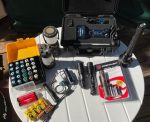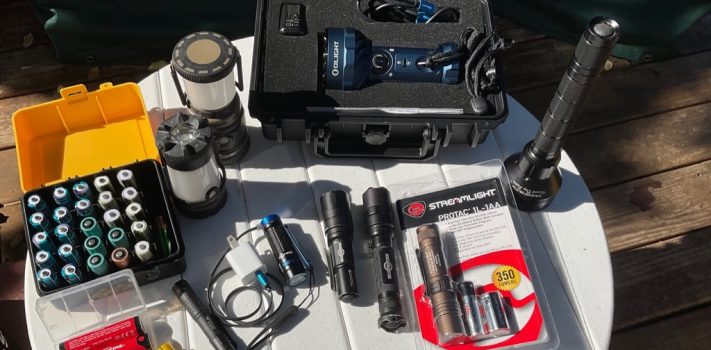“The light shines in the darkness and the darkness has not overcome it…” (John 1:5)
A real light can get people’s attention. Not long ago, as we sat inside of our home one night, I heard a thud sound and excited commotion on the street. I peeked out of the window and saw a car with people milling about. I went out on my deck to see if I could offer my assistance, using one of my favorite lights – a Malkoff ‘Hound Dog’1. Without pointing it directly at anyone, (I use the spill or edge of the beam) and lit up the area with the Malkoff’s 1600 lumens of bright light. The commotion turned out to be two teenaged girls who, if their story was true stated that they swerved to avoid an unknown animal and hit a tree. There was only minor damage to their vehicle and no medical attention was needed. As I was headed back into the house, I heard one of the girls ask the other, “was that the police?” She assumed that someone with a light as powerful as the one I had must be a police officer. When you think about that, it is not surprising since most of the population relies on their phone’s flashlight app as a flashlight. I am sure that most of the readers of SurvivalBlog already know this but would agree with me, your smartphone is not a flashlight.
At another time, my wife and I were at an Italian restaurant having dinner when the power went out due to a lightning storm. The entire place went dark. There was no generator back up and so it was pretty dim. My wife and I, within seconds, each took out of our packs a light and proceeded to continue enjoying our dinner. The restaurant owner was impressed that I was able to use the clip on a small AAA light and attach it to the window curtain, so it shined down on our table.
Believe it or not, even first responders can be unprepared when it comes to flashlights. As an EMT, I have been on medical calls where there were a half dozen or more responders from medical, fire, and police departments and I was the only one with a flashlight; so, we could move the patient out of the home and through the dark and unfamiliar yards to the ambulance safely.
Now in my mid-fifties, I have come to appreciate a good flashlight. They make life a whole lot easier. For example, making smaller print such as the rating of a car fuse or ingredients on a food package much more visible. With or without my reading glasses, I can read smaller type fonts with a reliable source of light.
The scenarios for needing a good flashlight are endless. Imagine you are in a building that is on fire. The smoke makes it darker. Then, the fire department arrives and cut the power. You are coughing from the fumes. A good flashlight can help you get oriented and perhaps help someone else, or help you get out safely.
Not Your Dad’s Maglite
In my lifetime, I have seen the transition from flashlight with bulbs to flashlights with LEDs or ‘light emitting diodes.’ It was a beautiful thing. No more did one have to worry about bulbs burning out and leaving you in the dark or needing to have spare bulbs available and lights that were not that bright most of the time. It was utterly amazing how bulbs would burn out at the worst possible time. The spare bulb in the tail cap of a ‘Mag Light’2 always got put to good use.
With LED flashlights, reliability became very high. The lifespan of the diodes were 50,000 hours or more. Reflectors around the bulb or LED have been redesigned to provide optimum throw or flood or a combination of the two. No more bulb replacements. Light lumen levels of 350, 500, 1,000, 2,000, or more lumens. As a side note, remember that the higher numbers generally represent lumens that are too bright for inside of the home in some cases, possibly affecting your night-adjusted vision and bouncing off the walls, blinding you if you had just woken up to a noise at 0300.
The flashlight consumer now has the option of low-price flashlights for $10 to $40, that are still dependable and extremely bright all the way to lights costing a couple or several hundred dollars that perform better than anything available in the past. Flashlights that you can trust your life too.
Flashlights are available with warm (more yellow), or cool (whiter), tints and powered by almost every battery known to man, with some being dual or multi fuel – able to run different batteries in the same light. Such as common AA cells and CR123 cells for example. It is truly a flashlight consumer best day.
So how do we sort through all these flashlights? This is the fun part. I like to think of flashlights as they fit in four categories:
First: Pocket or EDC (everyday carry), Flashlight(s)
These would be in the pocket almost all of the time. They would help to navigate a dark root cellar, look in the trunk of car for a lug wrench, or maybe under the front seat for the endless things that seem to drop down there.
To me, a single cell CR123 or AA flashlight is great for this but not the only choice. Generally, 250-350 lumens will be more than you will need for tasks like the ones mentioned and hundreds of other possible scenarios. Flashlights that use on AAA cell can be very small and bright enough for many tasks, but you will bet more lumens and more runtime out of an AA cell light in about the same size package.
Second: A defensive type of Flashlight
 A defensive role means a more powerful flashlight that will be with me when I walk the dogs at night or maybe navigating a parking lot after leaving a restaurant in the dark. Flashlights in the 500 – 1,000 or more lumen range are particularly good for this and will take away someone’s night vision if they mean you harm. This will give you time to react or escape, as necessary. It provides you with a huge advantage or edge. The element of surprise. Quite often, just lighting up the bad guy will cause him to find someone else to become a victim. Some of these lights such as the ‘Surefire Defender’ 3 have a crenellated bezel which means a somewhat scalloped or slightly pointed end surface that could be used as a defensive striking tool if needed. Flashlights also have the advantage to be able to go with you anywhere, within reason, where other types of defensive weapons or personal protection gear may be discouraged or not allowed.
A defensive role means a more powerful flashlight that will be with me when I walk the dogs at night or maybe navigating a parking lot after leaving a restaurant in the dark. Flashlights in the 500 – 1,000 or more lumen range are particularly good for this and will take away someone’s night vision if they mean you harm. This will give you time to react or escape, as necessary. It provides you with a huge advantage or edge. The element of surprise. Quite often, just lighting up the bad guy will cause him to find someone else to become a victim. Some of these lights such as the ‘Surefire Defender’ 3 have a crenellated bezel which means a somewhat scalloped or slightly pointed end surface that could be used as a defensive striking tool if needed. Flashlights also have the advantage to be able to go with you anywhere, within reason, where other types of defensive weapons or personal protection gear may be discouraged or not allowed.
These types of flashlights can be powered by many different types of cells, but common choices would be CR123 primary cells and 18650 rechargeable cells. Most of these flashlights have multiple settings such as low, medium, and high.
Third: Assistive Gear
Specialty flashlights such as headlamps, lanterns, red lights, and IR (infrared), lights can make tasks much easier when needed. There is nothing quite like a headlamp for having both hands available to work on a medical patient or gas up a generator. How about using a lantern to read a book when the power goes out? Streamlight4 makes some wonder little lanterns powered by AA cells, USB, 18650, and D type cells that are priced very reasonable. I like these so much that I have one of each and have also gifted them to family. Red lights do not affect your night adapted vision in any meaningful way. Such as a white light would do, and red lights do not alert game like a white light will. I find a lot of use for these while hunting. IR or infrared lights are for use with night vision. My Surefire Vampire IR/Red flashlight is perfect for this task and has to be experienced firsthand to fully understand.
Fourth: Bright Lights
Another category is bright lights, really bright lights. Flashlights in this group can make it seem like daylight outside when it is pitch black outside. Flashlights in this group can light paper on fire. I think of flashlights with lumen ratings from 5,000 – 100,000 lumens in this category. These workhorses are sometimes powered by built in nonremovable batteries that charge by USB or sometimes 18650 or similar rechargeable cells. Flashlights in this group can be used for search and rescue of people and pets, to stop traffic if needed, used to illuminate entire fields or buildings. Flashlights in this category are quite unlike anything you have seen or would expect from a flashlight. My ‘Olight Marauder 2’5 is 14,000 lumens and will light up a property better than a vehicle’s high beams. I have lit power line clearings for hundreds of yards with it. These flashlights can generate some heat and sometimes come with handles and runtime can drop off after a minute or several minutes but still remain seriously bright and are just plain fun to use. I have to mention that any of these lights, even the ones of just 350 or 500 lumens can permanently hurt someone’s eyes so one has to be exceptionally careful where they are pointed.
(To be concluded tomorrow, in Part 2,)










